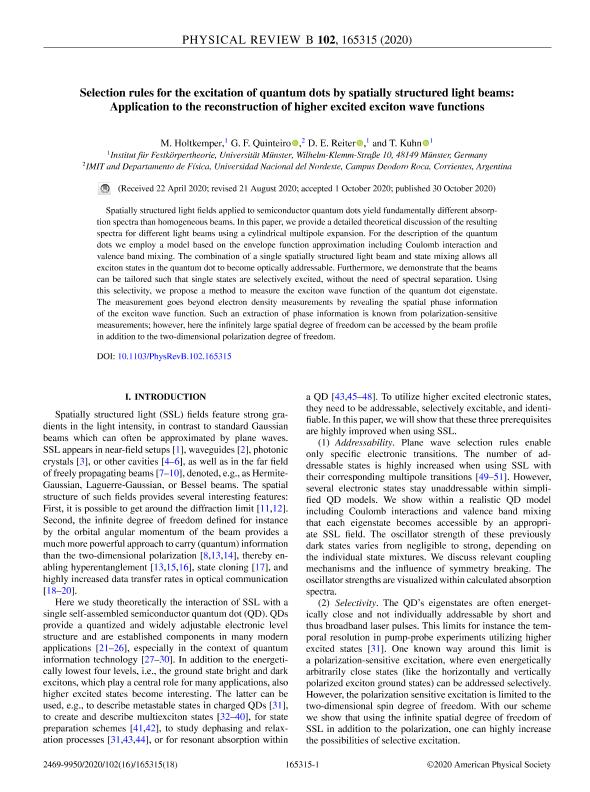Mostrar el registro sencillo del ítem
dc.contributor.author
Holtkemper, M.
dc.contributor.author
Quinteiro, Guillermo Federico

dc.contributor.author
Reiter, D.E.
dc.contributor.author
Kuhn, T.
dc.date.available
2022-10-03T12:52:35Z
dc.date.issued
2020-10
dc.identifier.citation
Holtkemper, M.; Quinteiro, Guillermo Federico; Reiter, D.E.; Kuhn, T.; Selection rules for the excitation of quantum dots by spatially structured light beams: Application to the reconstruction of higher excited exciton wave functions; American Physical Society; Physical Review B: Condensed Matter and Materials Physics; 102; 16; 10-2020; 1-18
dc.identifier.issn
2469-9950
dc.identifier.uri
http://hdl.handle.net/11336/171431
dc.description.abstract
Spatially structured light fields applied to semiconductor quantum dots yield fundamentally different absorption spectra than homogeneous beams. In this paper, we provide a detailed theoretical discussion of the resulting spectra for different light beams using a cylindrical multipole expansion. For the description of the quantum dots we employ a model based on the envelope function approximation including Coulomb interaction and valence band mixing. The combination of a single spatially structured light beam and state mixing allows all exciton states in the quantum dot to become optically addressable. Furthermore, we demonstrate that the beams can be tailored such that single states are selectively excited, without the need of spectral separation. Using this selectivity, we propose a method to measure the exciton wave function of the quantum dot eigenstate. The measurement goes beyond electron density measurements by revealing the spatial phase information of the exciton wave function. Such an extraction of phase information is known from polarization-sensitive measurements; however, here the infinitely large spatial degree of freedom can be accessed by the beam profile in addition to the two-dimensional polarization degree of freedom.
dc.format
application/pdf
dc.language.iso
eng
dc.publisher
American Physical Society

dc.rights
info:eu-repo/semantics/openAccess
dc.rights.uri
https://creativecommons.org/licenses/by/2.5/ar/
dc.subject
OPTICAL VORTEX
dc.subject
QUANTUM DOT
dc.subject.classification
Física de los Materiales Condensados

dc.subject.classification
Ciencias Físicas

dc.subject.classification
CIENCIAS NATURALES Y EXACTAS

dc.title
Selection rules for the excitation of quantum dots by spatially structured light beams: Application to the reconstruction of higher excited exciton wave functions
dc.type
info:eu-repo/semantics/article
dc.type
info:ar-repo/semantics/artículo
dc.type
info:eu-repo/semantics/publishedVersion
dc.date.updated
2022-07-04T20:00:06Z
dc.identifier.eissn
2469-9969
dc.journal.volume
102
dc.journal.number
16
dc.journal.pagination
1-18
dc.journal.pais
Estados Unidos

dc.journal.ciudad
New York
dc.description.fil
Fil: Holtkemper, M.. Westfälische Wilhelms Universität; Alemania
dc.description.fil
Fil: Quinteiro, Guillermo Federico. Consejo Nacional de Investigaciones Científicas y Técnicas. Centro Científico Tecnológico Conicet - Nordeste. Instituto de Modelado e Innovación Tecnológica. Universidad Nacional del Nordeste. Facultad de Ciencias Exactas Naturales y Agrimensura. Instituto de Modelado e Innovación Tecnológica; Argentina. Universidad Nacional del Nordeste. Facultad de Ciencias Exactas y Naturales y Agrimensura. Departamento de Física; Argentina
dc.description.fil
Fil: Reiter, D.E.. Westfälische Wilhelms Universität; Alemania
dc.description.fil
Fil: Kuhn, T.. Westfälische Wilhelms Universität; Alemania
dc.journal.title
Physical Review B: Condensed Matter and Materials Physics

dc.relation.alternativeid
info:eu-repo/semantics/altIdentifier/url/https://journals.aps.org/prb/abstract/10.1103/PhysRevB.102.165315
dc.relation.alternativeid
info:eu-repo/semantics/altIdentifier/doi/http://dx.doi.org/10.1103/PhysRevB.102.165315
Archivos asociados
